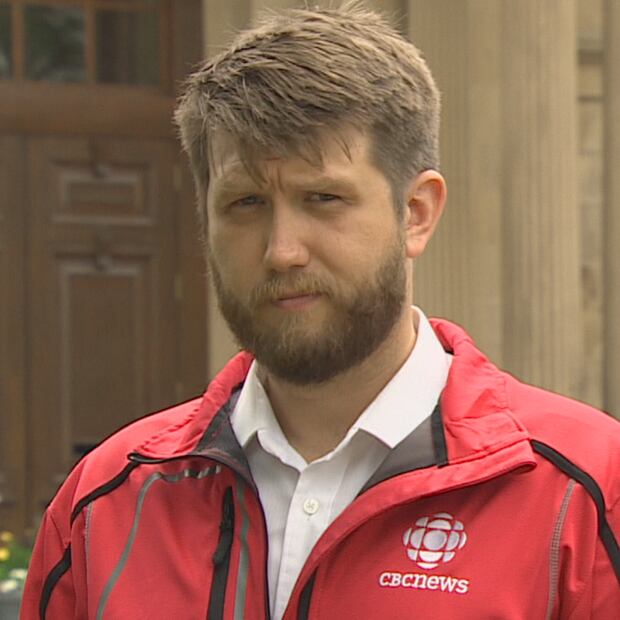87-year-old pilot ends elite flying career with cross-country flight to N.B.
George Miller's 68-year career at the controls ended at the airport that started it all

"Nobody's flown that low at this airport in 20 years."
That quip came from a Miramichi-Chatham Airport employee about 87-year-old George Miller's visit in his 1940s-era Ryan Navion.
Roaring by the eastern New Brunswick airport under a blazing sun, the Navion's unpainted silver fuselage reflected so much sunlight it stung the eyes.
The plane has a 1950s sci-fi movie spaceship vibe, from back when the future was made of chrome.
WATCH | George Miller's emotional final flight
Aircraft fanatics would recognize its fighter plane lineage. Designed by the same company that built the legendary Second World War P-51 Mustang, the Navion emits a throaty growl as it flies by.
They don't make planes like this anymore.
And on this spring afternoon, the Navion came out of the sky for the last time, touching down at the Miramichi-Chatham Airport.
It will never fly again.
Neither will its pilot.
Meet Miller
"I just love that airplane," said George Miller. "And I know that it'll be hard to finally take the last look at it."
"It's a real gut-wrencher to give it up."
After spending 68 years in the air, George Miller is saying goodbye to flying and goodbye to his Navion, flying it across Canada to donate it to a New Brunswick museum.
Born on Fogo Island off Newfoundland's north shore in 1935, Miller recalls being enraptured by a float plane delivering supplies to the island when he was just six years old.
On his 18th birthday, he signed up with the RCAF. For the next 35 years he was a fighter pilot. And it was this little New Brunswick airport that gave him his start.
'A crazy career'
In his early air force days, Miller says the first transonic fighter jets, planes capable of flying as fast as the sound barrier, were just coming into service. He put in a request to be trained to fly them. To this day, he still can't believe it was granted.
Miller moved to New Brunswick and started training to fly CF-86 Sabre fighter planes, an aircraft first flown against Russian MiGs in the Korean War.
The airport was a military hub then, much bigger than the humble airstrip it is today.

"This was our major, major fighter base, like Cold Lake is right now in Alberta," said Miller.
"It's part of my soul, really, because I grew up with it," said Miller of the Miramichi-Chatham Airport. "I was so involved with, and so engrossed with the whole fighter business and the air force."
Miller's first tour in 1955 was flying Sabres in Germany in the early years of the Cold War.
"Basically, that was to counter the impending Russian threat because the Russians … they really had plans on moving into Europe and the threat was real," said Miller. "And then, of course, we'd be in the Third World War."
Nuclear era
He eventually upgraded to the Canadair CF-104 Starfighter, a jet capable of flying at twice the speed of sound. It was also capable of nuclear strikes, carrying US-supplied nuclear weapons.
After piloting the Starfighters in Germany, Miller was transferred to Sardinia, Italy where he trained Canadian pilots on transporting and deploying nuclear weapons.
Miller ran a sea survival school, training pilots who ejected or parachuted over water how to survive.

He also spent time in the 1970s in Kingston, Ont., as the director of the Air Force Staff College, and then was sent to Egypt when that country was entering into peace talks with Israel.
"That was an amazing time in my career … and they gave me one year of intensive Arabic language training, so I became bilingual in Arabic … and I had some crazy missions across the 'no man's land.'
"I was often in the centre of it, trying to get intelligence for the Canadian government," said Miller.
After stints in Israel and Sudan, Miller retired after 35 years in the RCAF.
"That was a crazy career," he said.
Hawks and Snowbirds
Miller was also part of both of Canada's high-flying air force stunt squads.
His talent flying those first Sabres landed him a spot on the 1962 Golden Hawks squad. The Golden Hawks would showcase high-speed manoeuvres and stunts at airshows, wowing crowds across the country.

In 1973, he went to Moose Jaw, Sask., to help fashion the newly formed Snowbirds flight squadron into a national aerobatic team.
The Snowbirds still perform across Canada today.
Miller eventually formed his own flying aerobatic team after retirement, the Fraser Blues, flying alongside his son, putting on shows throughout British Columbia.
WATCH | George Miller shows off his 1940s-era Ryan Navion one last time
Miller's plane for those shows was the Navion. But despite still being in excellent health, this was the year to give up flying, he said.
"I feel very capable of flying, there's no problem there," he said. "But I think it's good to be sensible.
"I've done enough 'hundred-dollar hamburger' type trips, where you spend a hundred dollars in gas for a 15-dollar hamburger."
Donating history
When Miller started selling his beloved Navion, he spoke to Kevin Anderson, the executive director and founder of the New Brunswick Aviation Museum.
Anderson has been working since 2013 to create a museum showcasing the province's aviation history.
The current museum collection sits in a hangar off the tarmac at the Miramichi–Chatham airport. It already includes George Miller's flight suits from both the Golden Hawks and Snowbirds.
It will now also include the Navion.

Miller decided to cancel the sale of his plane and donate it to the fledging museum.
"Well, I had a pretty big smile on, I'll say that much," said Anderson.
"The reason that it was important for us to get it is that with the Golden Hawks being formed here in 1959 they were a huge part of Canada's aerobatic team history," said Anderson.

Trip of a lifetime
Miller decided to deliver the Navion to New Brunswick himself, making the final flight from his home in Langley, B.C.
His plan was to wait for good weather in early summer to fly across the country one last time.
But on May 1, as he was going to bed, he checked the weather on his phone. He was shocked to find the perfect tailwind flowing across Canada.
"I couldn't believe it," said Miller. "It was from coast to coast. This was a Sunday, and I said, 'I'm leaving Monday,' and I did."
The perfect co-pilot
But at 87, Miller knew he couldn't complete the trip alone. With any older plane, maintenance and upkeep is a constant variable, so he'd need someone who wasn't just along for the ride.
He chose 27-year-old engineer Freya Inkster.
"She's an absolutely wonderful maintenance engineer," said Miller.
A pilot herself, she maintains about 30 to 40 airplanes, including Miller's, and said she was honoured when he asked her to help him make his final flight.

A good thing too.
About halfway through the trip the Navion started having engine troubles and had to land in Kenora, Ont.
"I was thinking, 'Please don't be a cylinder,' but it was a cylinder," said Inkster.
She ended up having to replace it, shipping in a rebuilt one they luckily had back in Langley.
The rest of the flight went by without incident.
"This one is special," said Inkster. "Every single Navion is different, it doesn't matter if they were from the same year, every one is different."
Final landing
Last Thursday, after nearly seven decades of flying, Miller descended out of the sky for the final time.
To his surprise, two fire trucks arched streams of water across the runway as a welcome.
After an emotional hug with Anderson, Miller handed him the keys to his plane.
"An end of an era, that's for sure," said Miller.
"I'm hoping that when the new museum is open, I'll come back here, and I'll take Freya with me, and come back and see it, and that will be the last time I will see it."




